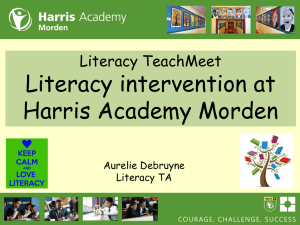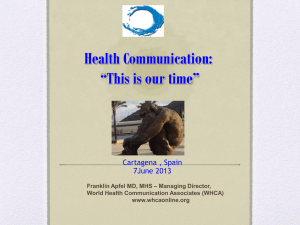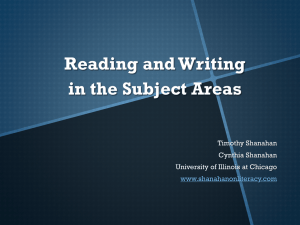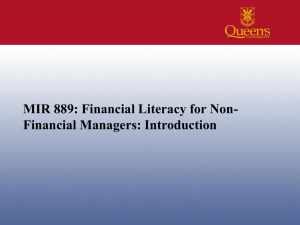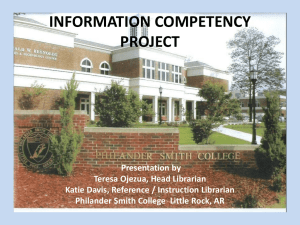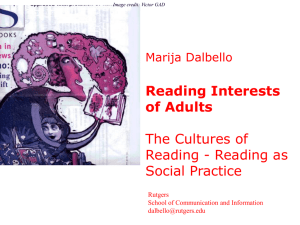What is media Literacy?
advertisement
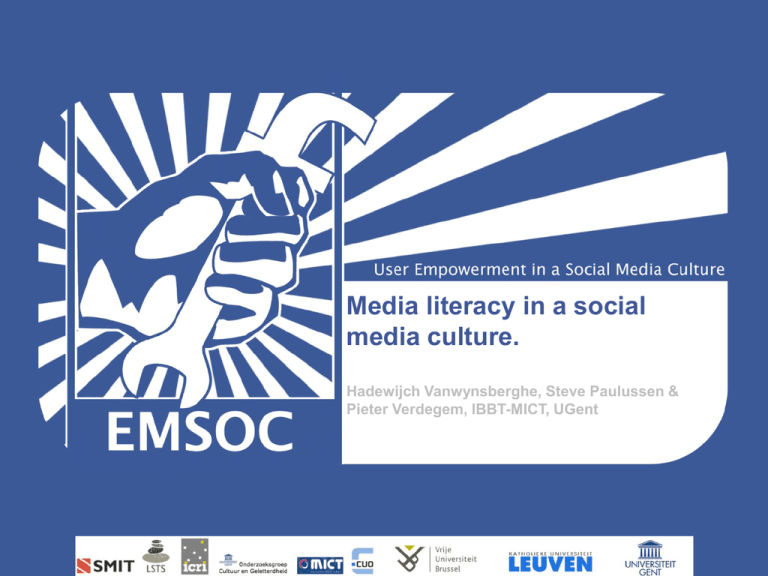
Media literacy in a social media culture. Hadewijch Vanwynsberghe, Steve Paulussen & Pieter Verdegem, IBBT-MICT, UGent EMSOC • EMSOC project – User Empowerment in a Social Media Culture – Inclusion, literacy & privacy – Empowerment= enabling people to control their own lives and to take advantage of opportunities (Van Der Maesen, 2002). – Website: www.emsoc.be • Focus: to develop a framework to measure media literacy (definition + conceptual model) Why media literacy? • Concerns about ‘the media’ are not new • New media technologies new challenges and new questions • (new) Opportunities & risks Why media literacy? • End 20th century: digital inequalities in access • Flanders 2010: Penetration/ ownership (IBBT, 2010) 86.10% 96.70% 81.00% 55.70% Computer Internet connection Digital television • New digital inequalities: – Participation gap – Transparency problem – Ethics challenge Mobile phone What is media literacy? • Several definitions of media literacy • Media literacy: What is media Literacy? • “ The ability to access, analyze, evaluate and create messages across a variety of contexts.” (Livingstone, 2004, p. 5) What is media Literacy? • European Commission: “media literacy is the competence to cope, autonomously and critcally, with the communication and media environment established within the consequense of the ‘information society” (EAVI study, 2009, p. 21) • EC makes a clear distinction between two dimensions: – 1) Individual competences (for example: technical use, critical understanding and social skills) – 2) Environmental factors (for example: media education, policies and regulation, media availability) (EAVI Study, 2009, p. 32) What is media literacy? • Knowing how to keep personal information private • Knowing that cyber bullying is as bad as bullying in real life What is media literacy? • Differentiate between media violence and real world violence • Recognize bias and stereotyping in the media What is media literacy? • Consume and produce media messages for civic engagement What is media literacy? • Understanding how media messages are constructed • Knowing which online information is reliable and knowing how to recognise correct information What is media literacy? • What is the purpose of media literacy (training)? Empowerment “enabling people to control their own lives and to take advantage of opportunities” (Van der Maesen & Walker, 2002, p.6) • A challenge of the information society: ensure that ALL people are empowered enough to deal with the opportunities and risks digital media pose. Measuring media literacy Before we can do something about the digital inequalities (example: media training), we must first have a good understanding of the existing level of ML of different groups and people in our society (= measure media literacy) • But first: know wherof media literacy is built create a conceptual framework of media literacy Analysis of existing literature • Media literacy: – Skills (Steyaert, 2000; Van Dijk, 2005; Van Deursen, 2010) – “Media literacy does not attach itself to a simple technical skill …” (EAVI, 2009, p.22): – Knowledge (Silverblatt, 1995; Messaris, 1998; Potter, 2004) – Attitudes (Tondeur et. al., 2010; Verdegem & Verhoest, 2009) – Self-efficacy (Brandtweiner et. al., 2010) “One’s capability to organize and execute the courses of action required to manage prospective situations”. (Bandura, 1995, p.2) • Media competences = • Competences vs skills: “The terms ‘competence’ and ‘key competence’ are preferred to ‘basic skills’ which was considered too restrictive as it was generally taken to refer to basic literacy and numeracy and to what are known variously as ‘survival’ or ‘life’ skills. ‘Competence’ is considered to refer to a combination of skills, knowledge, aptitudes and attitude, and include the disposition to learn in addition to know-how.” (Martin & Grudziecki, 2006, p.256) Analysis of existing literature • Level of media literacy further determined by media use: – Access ≠ use (Brandtweiner et. al., 2010) – Convergence: technology not coupled to the content (Jenkins, 2006) – Context (Hartmann, 2006) Analysis of existing literature • Level of media literacy also determined by influences from the environment (= external variables): External variables – Social influences (Venkatesh, 2003) – Training (Livingstone & Bober, 2004; Martens, 2010; Jenkins, 2006) – Social support (Bakardijeva, 2005; Stewart, 2007; Van Dijk, 2005) – Parental mediation (Rosen, 2008; Valcke, Bonte, De Wever & Rots, 2010; Bauwens, 2009) Building blocks of media literacy? Socioeconomics & demographics Media competences Media use External variables Conceptual model (work in progress) Correa (2010), Durndell (2002), Hsieh et. al. (2008), Livingstone & Bober (2004), Tondeur et. al. (2010) Fulk (1993), Valcke et al. (2007), Hobbs & Frost (2003), Jenkins (2006), Martens (2010) , Robinson et al. (2003) Van Deursen & Van Dijk (2008), Davis,(1989), Verdegem & Verhoest (2009), Ajzen (1985), Ferro et. Al. (2010), Meneses & Momino (2010), Livingstone & Helsper (2007), etc. Venkatesh (2003), Valente (1995), Fleming et. al. (2006), Valcke et. al. (2007), etc. The …… of the conceptual model • Going beyond a skills-based approach • Providing a broad interpretation of skills • Media literacy as its core (skills, knowledge & attitudes) is separetely described in the model as competences • Taking into account media use (access and use technology and content) and the context of media use • Having attention for external variables • Going beyond traditional socio-demographic and socioeconomic variables to describe digital inequalities • Media-independent Measuring media literacy? – Survey – Observations – Experimental design – Interview Combination of quantitative and qualitative research methods: Multitrait-Multimethod Hadewijch.Vanwynsberghe@UGent.be
